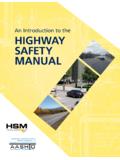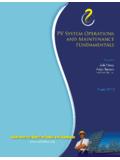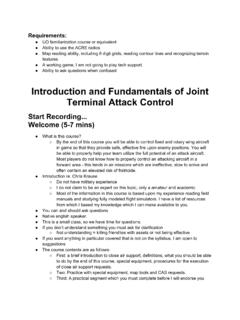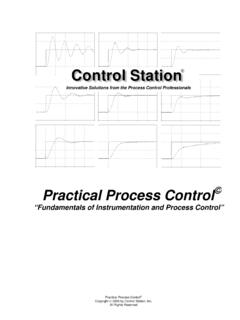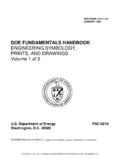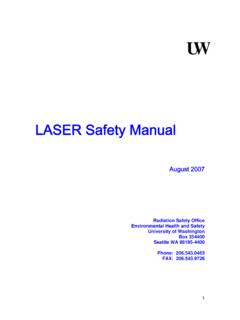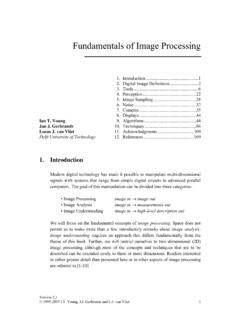Transcription of THE OPERATIONS PROCESS
1 FM 5-0 THE OPERATIONS PROCESSMARCH 2010 DISTRIBUTION RESTRICTION: Approved for public release; distribution is OF THE ARMYF orewordThe environment in which we conduct OPERATIONS is characterized by four clear trends: growing uncertainty, rapid change, increased competitiveness, and greater decentralization. Given these trends, our leaders must expect and be prepared to confront a variety of complex problems, most of which will include myriad interdependent variables and all of which will include a human dimension. With the publication of FM 5-0, The OPERATIONS PROCESS , and the introduction of design into our doctrine, we highlight the importance of understanding complex problems more fully before we seek to solve them through our traditional planning processes.
2 Design is neither a PROCESS nor a checklist. It is a critical and creative thinking methodology to help commanders understand the environment, analyze problems, and consider potential approaches so they can exploit opportunities, identify vulnerabilities, and anticipate transitions during a campaign. Commanders apply design to understand before entering the visualize, describe, direct, lead, and assess cycle. Einstein once said, If I were given one hour to save the planet, I would spend 59 minutes defining the problem and one minute resolving it. Combining design with the military decisionmaking PROCESS provides army leaders with a more comprehensive approach to problem solving under conditions of complexity and uncertainty.
3 The mission narrative produced through design enables leaders to articulate the context in which they operate to both subordinates and superiors addition to the introduction of design, this revision of FM 5-0 builds on and expands the body of doctrine associated with full spectrum OPERATIONS described in the 2008 edition of FM 3-0, OPERATIONS . Moving beyond planning and orders production, this manual holistically addresses planning, preparation, execution, and assessment in the continuous learning cycle of the OPERATIONS PROCESS . It reinforces the central role of commanders in the OPERATIONS PROCESS through battle command applying the art and science of understanding, visualizing, describing, directing, leading, and assessing OPERATIONS in exercising effective command and control.
4 The intent of FM 5-0 is to encourage greater flexibility through critical thought, action, and initiative. army leaders must not only develop effective plans, they must be able to convert those plans into timely action while maintaining the capability to reframe and adapt as the situation changes in an increasingly dynamic operational environment. MARTIN E. DEMPSEY General, army Commanding General army Training and Doctrine Command*FM 5-0 Distribution Restriction: Approved for public release; distribution is unlimited. *This publication supersedes FM 5-0, 20 January 2005, and FMI , 31 March 2006. i Field Manual No. 5-0 Headquarters Department of the army Washington, DC, 26 March 2010 The OPERATIONS PROCESS Contents Page v INTRODUCTION.
5 Vi Chapter 1 fundamentals OF THE OPERATIONS PROCESS .. 1-1 The Nature of OPERATIONS .. 1-1 Command and Control .. 1-3 The OPERATIONS PROCESS .. 1-9 Integrating Processes and Continuing Activities .. 1-12 Running Estimates .. 1-13 Chapter 2 PLANNING .. 2-1 Planning and Plans .. 2-1 Planning and the Levels of War .. 2-1 The Value of Planning .. 2-2 Conceptual and Detailed Planning .. 2-6 fundamentals of Planning .. 2-9 Key Components of a Plan .. 2-14 Chapter 3 DESIGN .. 3-1 Design Defined .. 3-1 Design Goals .. 3-2 Design in Context .. 3-3 Leading Design .. 3-6 Design Methodology .. 3-7 Chapter 4 PREPARATION .. 4-1 Preparation Functions .. 4-1 Preparation and the OPERATIONS PROCESS .
6 4-2 Preparation Activities .. 4-3 Chapter 5 EXECUTION .. 5-1 fundamentals of Execution .. 5-1 Responsibilities During Execution .. 5-3 Contents ii FM 5-0 26 March 2010 Decisionmaking During Execution .. 5-5 Rapid Decisionmaking and Synchronization PROCESS .. 5-8 Chapter 6 ASSESSMENT .. 6-1 Assessment fundamentals .. 6-1 Assessment 6-1 Assessment and the Levels of War .. 6-4 Considerations for Effective Assessment .. 6-5 Assessment Working Groups .. 6-9 Assessment Support .. 6-10 Appendix A COMMAND POST ORGANIZATION AND OPERATIONS .. A-1 Appendix B THE MILITARY DECISIONMAKING PROCESS .. B-1 Appendix C TROOP LEADING PROCEDURES .. C-1 Appendix D GUIDELINES FOR COMMANDER S PLANNING D-1 Appendix E army OPERATION PLAN AND ORDER FORMAT.
7 E-1 Appendix F TASK ORGANIZATION .. F-1 Appendix G RUNNING ESTIMATES .. G-1 Appendix H FORMAL ASSESSMENT PLANS .. H-1 Appendix I REHEARSALS .. I-1 Appendix J MILITARY BRIEFINGS .. J-1 GLOSSARY .. Glossary-1 REFERENCES .. References-1 INDEX .. Index-1 Figures Introductory figure-1. The OPERATIONS PROCESS .. vi Figure 1-1. Combining the elements of full spectrum OPERATIONS .. 1-3 Figure 1-2. The cognitive hierarchy .. 1-4 Figure 1-3. Battle command and the OPERATIONS PROCESS .. 1-9 Figure 2-1. The army problem solving model.
8 2-3 Figure 2-2. The planning construct .. 2-7 Figure 2-3. Commander s visualization .. 2-9 Figure 3-1. The design methodology .. 3-7 Figure 5-1. Decisions in execution .. 5-6 Figure 5-2. Rapid decisionmaking and synchronization PROCESS .. 5-8 Figure A-1. Functional and integrating cells .. A-3 Figure A-2. Integration of plans, future OPERATIONS , and current OPERATIONS .. A-5 Figure B-1. The steps of the military decisionmaking PROCESS .. B-3 Contents 26 March 2010 FM 5-0 iii Figure B-2. Mission analysis .. B-6 Figure B-3. COA development ..B-15 Figure B-4. Sample brigade COA sketch ..B-20 Figure B-5. COA analysis and war-gaming ..B-21 Figure B-6. Sample belt method ..B-26 Figure B-7.
9 Sample modified belt method using lines of effort ..B-27 Figure B-8. Sample avenue-in-depth method ..B-27 Figure B-9. Sample modified avenue-in-depth method using lines of effort ..B-28 Figure B-10. Sample box method ..B-28 Figure B-11. Sample modified box method using lines of effort ..B-29 Figure B-12. Sample synchronization matrix technique ..B-29 Figure B-13. Sample sketch note technique ..B-31 Figure B-14. COA comparison ..B-34 Figure B-15. Sample advantages and disadvantages ..B-34 Figure B-16. Sample decision matrix ..B-35 Figure C-1. Parallel planning .. C-2 Figure C-2. Planning at company and below .. C-3 Figure C-3. Sample schedule .. C-4 Figure C-4. Sample mission and COA statements.
10 C-9 Figure E-1. Paragraph layout for plans and orders .. E-4 Figure E-2. Annotated army OPLAN/OPORD format .. E-9 Figure E-3. Annotated attachment format (general) ..E-21 Figure E-4. Annotated WARNO format ..E-23 Figure E-5. Annotated sample FRAGO ..E-25 Figure E-6. Example of overlay order graphic ..E-26 Figure F-1. Sample outline format for a task organization (52d Infantry Division) .. F-5 Figure G-1. Generic base running estimate format .. G-2 Figure H-1. Sample of end state conditions for defensive OPERATIONS .. H-3 Figure H-2. Sample of end state conditions for stability OPERATIONS .. H-4 Figure H-3. Sample assessment framework .. H-6 Figure I-1. Rehearsal techniques.










